Vol 3 No. 29 TROPIC LIGHTNING NEWS July 15, 1968
Index
| Unit Page | Unit Page | Unit Page | Unit Page |
| 1/5 8 | 2/22 1 | 25th Psyops 6 | 4/23 Photos 7 |
| 1/27 1 | 2/34 Armor 8 | 25th Psyops Photos 6 | 554 Engr 1 |
| 1/27 8 | 25th MP 4 | 3/4 Cav 1 | 34th ARVN Rangers 1 |
| 101st Airborne 1 | 25th MP Photos 4 | 4/23 Photos 7 | |
| 2/14 Photo 1 | 25th Psyops Photos 6 | 4/23 7 |
Triple Deuce Double Deals To Whip VC
CU CHI - Soldiers of the 2d Bn (Mech), 22d Inf along with ARVN
Rangers and reinforced by elements of the 3d Sqdn, 4th Cav and 3d Bde, 101st
Airborne Div, accounted for 45 enemy dead in two separate engagements near Trang
Bang.
The first encounter occurred 48 kms northwest of Saigon during a
reconnaissance-in-force sweep involving B Co of the Triple Deuce and A Co of the
ARVN 34th Ranger Bn.
The combined force made contact in a densely wooded area about 8
kms north of Trang Bang. They received heavy RPG, machine gun and small
arms fire from well-fortified positions, occupied by an estimated 150-200 North
Vietnamese Army Regulars.
An hour earlier, the Allied force had received a few rounds of
sniper fire with no friendly casualties sustained. As the force approached
the heavily vegetated area about noon, Captain Malcom G. Waitt, CO of B Co, from
Erie, Pa., deployed his armored personnel carriers on line. The ARVN
Rangers walked between and to the front of the vehicles.
According to Waitt, “Everything was quiet until we got about 300
meters into the treeline. Then they opened up with everything they had, to
include RPG’s, .51 caliber machine guns, and small arms fire.” Waitt continued,
“Because ‘Charlie’ was in such well-fortified positions and had very good
fields of fire, I pulled my forces back and pounded the area with artillery,
gunships, and air strikes.”
After a heavy exchange of fire for 20 minutes, the Allied force was
reinforced by the Triple Deuce’s Alpha Co and C Trp of the 3d Sqdn, and
sporadic fire continued until 6:55 p.m. Artillery fire continued to pound the
area into the night.
A sweep of the battle area the following morning revealed 21 enemy
bodies and several items of North Vietnamese equipment and ammunition.
Two days later and 15 kms northwest of the first encounter, A Co,
2d Bn (Mech), 22d Inf, came under heavy attack from two Viet Cong platoons.
The enemy hurled small arms, automatic weapons, and RPG fire at the infantrymen
who countered with all organic firepower calling in gunships, artillery and
tactical fighters.
Five hours after the initial contact, fire ceased, leaving 24 VC
dead. Two VC suspects were detained by the Tropic Lightning soldiers who
also captured two assault rifles and a CHICOM machine gun.
 |
ALMOST - Specialist 4 Bryon Longero of Sacramento, Calif., a grenadier for the 2d Bn, 14th Inf puts his best foot forward but misses his objective by scant inches and lifts himself out of the muck to continue his mission. (Photo By SP4 Larry Weist) |
Careless VC Pointman Ambles Into An Ambush
2D BDE - The Recon Plt of the 25th Inf Div’s 1st
Bn, 27th Inf
Wolfhounds sprang an ambush killing a Viet Cong point man who walked unknowingly
into their midst in the early morning hours.
The platoon had set up their ambush along the Hoc Mon Canal near
the Saigon River.
Private First Class Donald Hastings, El Paso, Tex., said, “I had
positioned myself in a canal drainage ditch so I could see both up and down the
canal and a nearby trail. We thought both were likely avenues of
approach.”
“A little after midnight I saw movement to my front. From
what I could see it appeared to be a VC point man,” Hastings reported. “I passed the word back, and we waited awhile as the man came closer to us.
Soon three more men appeared.”
“I allowed the point man to pass by me hoping that we could get
the others in our kill zone. Before the three could get in range the point
man saw that he was in the middle of our ambush. I opened up with my M-16
on the point man while the rest of the platoon reconned by fire the area where
the other three had taken cover,” Hastings recalled.
While sweeping the area the following day the Wolfhounds discovered
one VC body.
| The end of an era! July will see the last copy of the 25th Inf Div magazine, Lightning 25, distributed to division personnel. A new magazine, published quarterly, with a larger format and full color photography is under way. “Thunder, the Voice of Tropic Lightning” will be seen for the first time in September. Don’t miss it! |
A T o u c
h O f S t a t e s i d e C o m e
s T o C u C h i
A new facility has been added to Cu Chi Base Camp for use when 25th
Inf Div troops come in from the field. The new Ilikai East Service Club
officially opened June 30.
The new club, covering 8,000 square feet of ground, is
air-conditioned and capable of serving 300 soldiers at one time.
Major General F. K. Mearns cut the ribbon in the main doorway at
1330 hours, opening the doors to division troopers on a seven day a week
schedule.
In a short dedication message, he said, “This is a house of
recreation, amusement and delight and ... I hereby dedicate it to that aim.”
Among the club’s facilities are an art room, tape room, library,
projection room, two music rooms, two television lounges, a central patio, game room,
stage and auditorium, kitchen and serving windows.
In the game room, four pool tables, a German football game plus
table games are available. Musical instruments are ready to be checked out
and there are plenty of chairs for relaxation.
Three girls will staff the club and organize functions for
battalions returning from the field. Regular activities, such as indoor
movies, cook-outs and patio parties are also planned.
A full kitchen facility including pizza ovens and waffle irons will
lend themselves to such functions. Games for prizes will be held
frequently.
Built by C and D Cos, 554th Engr Bn, in cooperation with volunteers
from the Adjutant General’s office, Military Police, 1st Logistical Command
and Vietnamese national labor, the building has taken a year to build and
features walnut stained walls, cement floor and rattan furniture.
The club will be open Mondays from 1300 to 2200, Tuesdays through
Saturdays from 1200 to 2200; and Sundays from 1000 to 2200 hours.
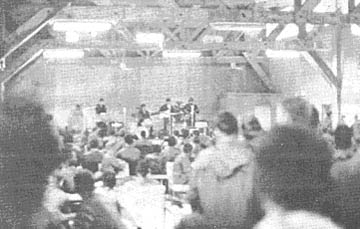 |
ILIKAI EAST - Music ranges from cool to hot; and it’s strictly stateside. Opening day finds troops really enjoying a touch of home. . . . And it’s here to stay! |
Page 2 TROPIC LIGHTNING NEWS July 15, 1968
Decorated
| DISTINGUISHED FLYING CROSS | |
|
LTC A. M. Dean, HHB, 1st Bn, 8th Arty MAJ Roger McLeod, Co A, 25th Avn Bn CPT Terence M. Henry, 116th Aslt Hel Co, 269th Avn Bn CPT James L. Jaap, Co A, 25th Avn Bn 1LT David E. Henard, Co B, 25th Avn Bn |
WO1 Jon M. Barnhill, Co B, 25th Avn Bn WO1 Wesley J. Ashenbrenner, D Trp, 3d Sqdn, 4th Cav SP5 Edward T. Lyons, Co B, 25th Avn Bn SP4 Daniel L. Thacker, Co A, 25th Avn Bn SP4 Robert L. Hollister, Co A, 25th Avn Bn |
|
BRONZE STAR MEDAL (HEROISM) |
|
|
BG Donald D. Dunlop, HHC, 25th Inf Div LTC Thomas C. Lodge, HHC, 1st Bn, 5th Inf MAJ Gordon G. Corcoran, HHC, 2d Bn, 27th Inf MAJ Robert E. Yoos, HHC, 2d Bn, 14th Inf CPT Peter E. Gleszer, HHC, 2d Bde CPT William E. Shaffer, C Trp, 3d Sqdn, 4th Cav CPT Tobert L. Hemphill, HO, 3d Bn, 22d Inf 1LT William A. Bates, Co B, 4th Bn, 23d Inf 1LT Rodney S. Nishimura, A Trp, 3d Sqdn, 4th Cav 1LT Gary J. Stevens, Co D, 2d Bn, 27th Inf 1LT James R. Brown, Co B, 1st Bn, 27th Inf 1LT William S. Fulcher, Co D, 3d Bn, 22d Inf 1LT Mickey R. Miller, Co C, 1st Bn, 5th Inf 1LT Charles J. Boyle, Co C, 3d Bn, 22d Inf 1LT Antonio F. Sanpere, Co B, 2d Bn, 14th Inf 2LT Michael Donnelly, Co C, 3d Bn, 22d Inf WO1 Mackie A. Webb, D Trp, 3d Sqdn, 4th Cav SGM Charles Buster, HHC, 2d En, 34th Armor PSG Salvatore F. Pesta, Co A, 1st Bn, 27th Inf SSG Robert L. Carden, B Trp, 3d Sqdn, 4th Cav SSG Robert Featherston, Co A, 2d Bn, 22d Inf SSG James Coleman, Co A, 3d Bn, 22d Inf SSG Ray I. Russler, HHC, 2d Bn, 22d Inf SP5 Richard J. Hopkins, Co C, 1st Bn, 5th Inf SGT William B. Babin, Co A, 4th Bn, 23d Inf SGT Richard A. Walters, 44th Inf Pit (Sct Dog) SGT Natal V. Acevedo, Co D, 2d Bn, 27th Inf SGT Theodore W. McDuff, Co A, 2d Bn, 22d Inf SP5 Wincel A. Morris, HHC, 1st Bn, 27th Inf SP4 Howard L. Hayden, HHC, 4th Bn, 23d Inf SP4 Herbert J. Bergman Jr., Co D, 2d Bn, 27th Inf |
SP4 Nelson E. White, Co A, 4th Bn, 23d Inf SP4 Douglas L. Edwards, Co D, 2d Bn, 27th Inf SP4 Charles A. Rouse, Co A, 2d Bn, 27th Inf SP4 Ronald N. Boyd, A Trp, 3d Sqdn, 4th Cav SP4 Alvin E. Veldkamp, Co A, 4th Bn, 23d Inf SP4 Jerome N. Custer, HHC, 1st Bn, 27th Inf SP4 John M. Uzarski, Co B, 4th Bn, 9th Inf SP4 Larry D. Stewart, HHC, 4th Bn, 9th Inf SP4 Mark A. Madden, Co A, 4th Bn, 23d Inf SP4 Terry R. Willingham, Co D, 3d Bn, 22d Inf SP4 David L.. Chrestiansen, D Trp, 3d Sqdn, 4th Cav SP4 Cecil E. Guthrie, HHC, 2d Bn, 22d Inf SP4 Michael H. Mellman, HHC, 2d Bn, 27th Inf SP4 Carl E. Pfromm, Co B, 1st Bn, 27th Inf SP4 Jerome D. Spence, HHT, 3d Sqdn, 4th Cav SP4 Rodric L. Schultz, 7th Bn, 11th Arty SP4 Edgar Ryan, Co B, 4th Bn, 9th Inf SP4 Warren Fien, HHT, 3d Sqdn, 4th Cav PFC Edward Runge, Co C, 3d Bn, 22d Inf PFC Charles W. Payne, Co B, 4th Bn, 9th Inf PFC William Wilson, Co B, 4th Bn, 9th Inf PFC Richard Marrero, HHC, 2d Bn, 22d Inf PFC Robert J. Tinnetti, Co D, 2d Bn, 22d Inf PFC Douglas Hill, Co D, 2d Bn, 22d Inf PFC Jack O. Baumstark, Co B, 4th Bn, 9th Inf PFC Donald R. Elverd, Co C, 1st Bn, 5th Inf PFC Tommy W. Johnston, HHC, 4th Bn, 23d Inf PFC William A. Kestell, HHC, 4th Bn, 23d Inf PFC Ronald M. Grim, Co C, 1st Bn, 5th Inf PFC George A. Sloan, Co B, 4th Bn, 9th Inf PFC Patrick S. Clark, Co C, 1st Bn, 5th Inf |
|
ARMY COMMENDATION MEDAL (HEROISM) |
|
|
MAJ Billy R. Vinson, D Trp, 3d Sgdn, 4th Cav 1LT Michael C. Long, Co D, 2d Bn, 14th Inf WO1 Peter Webb, D Trp, 3d Sqdn, 4th Cav WO1 Charles P. Eastes, D Trp, 3d Sqdn, 4th Cav WO1 Bruce F. Wood, D Trp, 3d Sqdn, 4th Cav |
SFC Charles E. Jackson, HHC, 2d Bde SSG Willard Schweninger, Co D, 2d Bn, 14th Inf SSG Robert E. VanCleave, D Trp, 3d Sqdn, 4th Cav SSG Fergus E. Bohen, HHT, 3d Sqdn, 4th Cav SSG David B. Xanten, B Trp, 3d Sqdn, 4th Cav |
DoD Expands Action Against Military Housing Discrimination
Secretary of Defense Clark M. Clifford has ordered two new actions
in the Defense Department’s campaign to eliminate housing discrimination
against military men and their families.
Secretary Clifford announced these orders:
“After July 31, no member of the Armed Forces stationed at a base
in the United States will be authorized to enter into a new lease or rental
arrangement at an apartment or trailer court near his base if the owner follows
a discriminatory policy in leasing to servicemen.”
“Procedures will be established as quickly as possible to make
legal advice available to any serviceman who experiences housing discrimination.
This help will include counseling him, if he so wishes, on his right to bring a
law suit against a discriminatory landlord under the 1866 law upheld this week
by the Supreme Court.”
In the final session of its 1967-68 term, the U.S. Supreme Court
declared that the 1866 law to which Secretary Clifford referred bars all racial
discrimination, private as well as public, in the sale or rental of property.
In reporting on the year-old intensive campaign against
discrimination in apartments and trailer courts near military installations,
Secretary Clifford said:
“In July, 1967, only 61 per cent of these rental units were open
to all servicemen regardless of race or color. Now 83 per cent are open to
all members of the Armed Forces. This is a gain of 247,000 open housing
units.
“We are gratified by the progress in the last 12 months, but
unfortunately there are still some landlords who discriminate on the basis of
color against men who wear the uniform of their country. This is an
intolerable injustice.”
Subdued Insignia Ok’d For Army Field Clothes
Members of the U.S. Army around the world have been authorized to
Wear subdued insignia on field jackets, tropical combat uniforms, fatigues and
OG (olive green) shirts.
The subdued items may be worn as they become available beginning
July 1, and they will be mandatory effective July 1, 1969.
Soldiers in Vietnam already are wearing subdued insignia of grade,
which prevent easy identification of leaders by the enemy.
Officer insignia of grade and branch is to be pin-on or sew-on
subdued insignia. Silver insignia of grade will be black on olive green,
and gold insignia of grade will be russet (reddish brown) on olive green
background.
Enlisted insignia of grade are to be pin-on subdued insignia, to be
worn on both collars of the uniform and on field and pile caps instead of
distinctive insignia. In addition, the pin-on insignia are to be worn on
the white uniforms of medical and mess personnel.
Also authorized are subdued organizational shoulder and sleeve
insignia and subdued pin-on and sew on combat and special skill badges. (ANF)
Did You Know?
Did you know that although a Betsy Ross commemorative stamp has
been issued by the U.S. Post Office Department, most historians, in view of the
lack of documentary evidence, now doubt that she made the first flag?
Army Draft Set At 18,300 For August
The Department of Defense has requested the Selective Service
System to provide 18,300 inductees to be assigned to the U.S. Army in August.
The Defense Department said the request supports currently approved
force levels and will assure timely flow of replacements for men completing
their terms of service.
The Mission In Vietnam
In describing the war in Vietnam recently, President Johnson
through his description, made a capsule outline of the United States mission in
this country.
“There is the face of armed conflict - of terror and gunfire - of
bomb heavy planes and campaign-weary soldiers.
“The second face of war in Vietnam is a quest for political
solution - the face of diplomacy and politics.
“The third face . . . is, at once, the most tragic and hopeful.
It is the face of human need. It is men and women, many without shelter,
with rags for clothing, struggling for survival in a very rich and fertile
land.”
The TROPIC LIGHTNING NEWS is an authorized publication of the 25th
Infantry Division. It is published weekly for all division units in the Republic of
Vietnam by the Information Office, 25th Infantry Division, APO San Francisco
96225. Army News Features, Army Photo Features, Armed Forces Press Service and Armed
Forces News Bureau material are used. Views and opinions expressed are not necessarily
those of the Department of the Army. Printed in Tokyo, Japan, by Pacific Stars and
Stripes.
MG F. K. Mearns . . . . . . . . . Commanding General
MAJ Andrew J. Sullivan . . Information Officer
2LT Don A. Eriksson . . . . . Officer-in-Charge
SP4 Stephen Lochen . . . . . Editor
SP4 Bill Berger . . . . . . . . . . . Editorial Assistant
Page 3 TROPIC LIGHTNING NEWS July 15, 1968
Page 3 of this issue, which has not been included as part
of this on-line reproduction, contains a list of state poll dates, offices open
for nomination, qualifications for voting, voting registration dates and
information on requesting absentee ballots and information on returning the
ballots.
Page 4-5 TROPIC LIGHTNING NEWS July 15, 1968
MP’s Checkpoints Spell ‘NIX’
For Contraband And
‘Charlies’
|
Story And Photos |
1ST BDE - Alone, miles from an Allied base, the 25th Military
Police Company’s Resources Control Team daily checks the flow of contraband on
the roads in Tay Ninh Province.
Operating out of the 25th Inf Div’s Tay Ninh Base Camp, the
three-man team works with Vietnamese National Police to pick up Viet Cong
suspects and seize black market contraband and supplies destined for enemy
hands.
With more than 500 miles of road to cover, the team has set up
checkpoints as far west as the Cambodian border, as far north as the base of Nui
Ba Den, and as far as 20 miles south of Tay Ninh.
Their method is simple but effective. Each day, sometimes
before the sun is up, the team joins their Vietnamese counterparts at the
National Police compound in Tay Ninh. Here, they receive the exact
location of the day’s checkpoints.
The location is kept secret until the MP’s move out, because the
enemy has made no secret of the fact that they would like to be rid of the
Resources Control team. And if word of the next day’s checkpoint leaked
out, the enemy might get their wish.
At a different spot each day, the MP’s wait until the Vietnamese
police clear the checkpoint area with a mine sweeper before the day’s work
begins.
Then as vehicles come down the road and through the checkpoint the
policemen search them. Contraband can be carried anywhere, so the search must be
thorough. And because the individuals on the roads could be Viet Cong,
they are also checked for identification.
If a person has no ID card, he is detained by the Vietnamese police
and brought back to the consulate station. Likewise, if in the judgement
of the team, an individual ought to be detained because of the type or amount of
contraband he is carrying, he is also detained and then interrogated by the
National Police.
According to team leader Specialist 4 Bobby Fowler from Bayonne,
N.J., 65 percent of the people they detained during the three months following
the inception of the resources program were later found to be confirmed Viet
Cong. Lately, the team has detained about 40 suspects a month.
How can the team determine what is contraband? The Vietnamese
government has set a 20-kilo limit on rice that is carried on the roads.
If an individual has more than that amount, he must have in his possession
papers showing that he obtained the rice legitimately and that the rice will not
be used by the enemy.
Some items are obviously contraband. C-rations destined for
black markets, batteries and wire when found in excessive quantities,
ammunition, shrapnel and uniforms are confiscated.
Rice is the contraband item most taken by the team. In fact,
they have seized more than 125,000 pounds of it, or enough to feed more than 50
enemy battalions for a month. Contraband medicine is also seized in large
amounts - antibiotics being seized in the biggest quantities.
The work of the Resources Control Team not only deprives the enemy
of desperately needed food and supplies. The team also supplies
intelligence information.
Is the team’s job dangerous? To talk to the men on the
team, you wouldn’t believe it was. But, one of the team members’ has
been individually threatened by name in an enemy report received through
intelligence channels. However, the 1st Brigade soldier involved is SP4
Fowler who shrugs off the threat.
Another team member philosophized about the danger.
Specialist 4 John Kevilly from Washington, D.C., stated that being shot at or
threatened is just another indication that the team is doing its job and doing
it well.
But the team doesn’t need this kind of indication. The
record speaks for itself. The Resources Control Team has been remarkably
efficient in hurting the enemy’s war effort in the 1st Brigade’s area of
operations.
 |
CONTRABAND - As more vehicles approach the checkpoint, the Resources Control Team searches for contraband goods carried on the roads of Tay Ninh Province. The team checks over 1,200 vehicles a week for contraband goods. |
| ID CHECK - A Vietnamese policewoman asks a woman who passed through the checkpoint for identification. Team Leader Specialist 4 Bobby Fowler, asks the policewomen to help when females are checked for identification and contraband. |  |
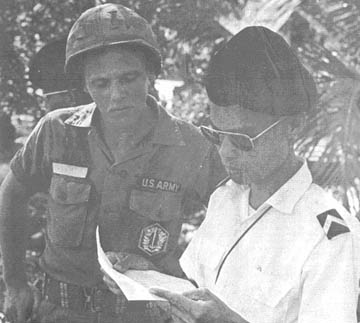 |
CHECKPOINT - Resources Control Team Leader, Specialist 4 Bobby Fowler, and a Vietnamese National Policeman scrutinize papers carried by a Vietnamese man who attempted to pass through the checkpoint with two large packages of camouflaged uniform material. |
| SUSPICIOUS PACKAGE - Specialist 4 John Kevilly of Washington, D.C., inspects a suspicious-looking package he found in a bag carried by a Vietnamese woman. |  |
 |
ANYWHERE AND EVERYWHERE - Contraband can be carried anywhere, so team member Specialist 4 Calvin Buchanan from Washington, D.C., checks for it everywhere. However, Buchanan didn’t find anything hidden in the bundles of grass on the back of this man’s bicycle. |
Page 6 TROPIC LIGHTNING NEWS July 15, 1968
Psyops
-- Weaponless War Of Words
 |
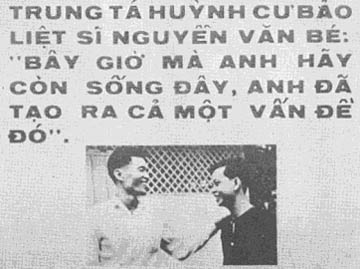 |
| CAPTAIN Audris Endrijonas adjusts the 1,000-watt speaker system mounted in a U6A Beaver, prior to an aerial Psyops mission from the 25th Inf Div base camp at Cu Chi. | HIGH RANKING CHIEU HOI - Lieutenant Colonel Huynh Cu, former Chief of VC Training Section, Military Region V, is pictured on Psyops leaflet encouraging VC guerrillas to rally to the government. |
Leaflets And Loudspeakers
Persuasion In Stereo – Allies
CU CHI - In Vietnam, battles are fought daily with M-16 rifles,
grenade launchers, helicopter gunships, artillery, and air strikes. But,
there’s “another” war being fought in Vietnam today. It’s not a
conflict of guns and bullets, but a war fought with words.
“Never in the history of the United States have we practiced a
more extensive use of psychological warfare tactics, than in Vietnam,”
remarked Captain Audris Endrijonas, 25th Inf Div psychological operations (Psyops)
officer.
“Last month.” he continued, “we dropped approximately 22
million leaflets over the division’s area of operations. Another 30,000
leaflets were disseminated by ground teams, and 98 hours of loudspeaker
broadcasts were logged.”
The basic purpose of Psyops is to convince the North Vietnamese
Army forces and Viet Cong guerrillas that the South Vietnamese government is the
true government of Vietnam. “We try to take advantage of a psychological
weakness of the enemy in a particular situation,” added Endrijonas.
If the VC or North Vietnamese have a large number of sick or
wounded on the battlefield, and no medical supplies to treat them, the Psyops
teams spring into action.
The teams develop a theme based on that particular weakness and
then deliver the message by means of either aerial or ground loudspeaker
broadcasts, or printed leaflets.
The message presents an opportunity for the enemy to “Chieu
Hoi”, or rally to the government of South Vietnam. He is assured he will be
treated not as a prisoner but as a citizen of the Republic of Vietnam.
Upon rallying to the government, the former enemy soldier is sent
to a special Chieu Hoi center where he learns what the South Vietnamese
government stands for and how it functions. After the indoctrination
period he may remain at the center if he chooses, or the government will help
him find a job.
Not all psychological messages are aimed at enemy forces.
Frequently, messages are directed to the family of a VC member. This is an
indirect approach, but very often successful because of the extremely strong
family ties associated with the Vietnamese society.
Many broadcast messages are made encouraging the Vietnamese
citizens to report Viet Cong activity in their area. Leaflets inform the
civilians of rewards they may collect for giving information to the whereabouts
of enemy troops, equipment, or supplies. Many rewards have been given to
villagers for reporting VC weapon caches.
When American or allied fighting units come in heavy contact with
enemy forces, a Psyops team flies over the battle scene, saturating the area
with propaganda leaflets, and broadcasting taped messages over a 1,000 watt
loudspeaker. Both helicopters and fixed-wing aircraft are used in the
Psyops flights. Ground teams carry 250 watt “back-pack” speakers,
which have been used extensively in coaxing the enemy from tunnel complexes.
The actual production of broadcast tapes and writing of propaganda
leaflets is handled by Vietnamese interpreters. American teams give the
interpreter a general theme to follow, which he writes or records in his own
words. According to Captain Endrijonas, “this eliminates the American
touch in the messages. We put the ethnic background and inherent language
capabilities of the Vietnamese to maximum use.”
In addition to furnishing interpreters, the Vietnamese also have
their own Psyops teams. These teams from Vietnamese Army units have
loudspeaker and audio visual capabilities, as well as the facilities to produce
printed messages.
Often a Vietnamese team accompanies American Medical Civil Action
Program (MEDCAP) teams into villages, informing the civilians of the medical
attention available. Movies with various propaganda themes and overtones
are often shown. The Vietnamese teams tell the villagers the difference
between living under Viet Cong rule and the rule of the people.
Is the Psyops program working? There is no sure way of
measuring the success of the program, but a significant number of Chieu Hois
monthly indicates that the messages are getting through to the people.
During 1967, 27,000 enemy troops rallied to the Republic of Vietnam
under the Chieu Hoi Program. Of this number, 17,000 bore weapons.
Perhaps an even greater indication can be seen in the demand of the
North Vietnamese delegation at the Paris peace talks that the United States end
the dropping of leaflets and cease the conduct of all psychological operations
in Vietnam.
|
Story And Photos By SP4 Joe Moore |
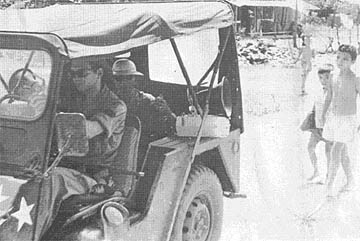 |
REPORT VC ACTIVITIES - Member of Vietnamese Psyops team tells villagers 16 kms northwest of Saigon to report any Viet Cong activity to government or allied forces. |
| PSYOPS TEAM - Vietnamese Psyops team member tells villagers that medical assistance is available at nearby American Medical Civic Action Program (MEDCAP) site. |  |
Page 7 TROPIC LIGHTNING NEWS July 15, 1968
| Story And Photos By SP4 Walt Chaikivsky |
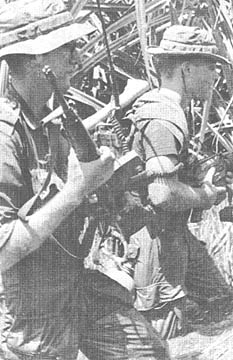 |
SPLASH! - A 25th Inf Div artillery forward observer, Second Lieutenant John Russell (left) of Corpus Christi, Tex., and his radio-telephone operator, Private First Class Steven Murphy of Butte, Mont., call in an unusual “splash” |
| IT’S DRY - Tomahawks of the 4th Bn (Mech), 23d Inf, 25th Inf Div, find pleasure on a dry berm after eight hours of tromping through swamps 12 kms northwest of Saigon. | 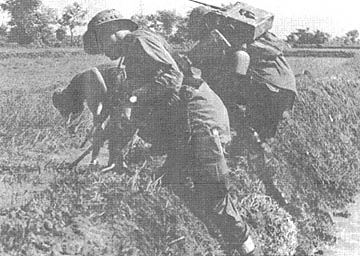 |
Scourge Of The Monsoon Rains;
Tomahawks Keep Pushing
2D BDE - With the arrival of the monsoons - and of course the mud -
the 4th Bn (Mech), 23d Inf has been forced to leave their armored personnel
carriers behind while on reconnaissance in force missions. Without the
added fire power of the track-mounted .50 caliber machine guns the Viet Cong
might assume the Tomahawks would become stale.
On the contrary they have proven that they are infantrymen in the
true sense of the word. Sergeant Major John E. Wise of Petersburg, Va.,
said: “The 50’s are not a crutch for us but rather an additional weapon to
complete our mission more efficiently.”
From mounted to dismounted, the Tomahawks adapted to the tactics of
the “straight leg” not by hour blocks of instruction but rather by assuming
the walking game of war, on the ground, on the job.
The unit’s first major mission was to seek out the Viet Cong
rocket sites menacing Saigon. Choppers replaced APC’s as the Tomahawks
made eagle flights for the first time in over a year. They learned that
mud, rain, and chest-deep water are the enemies’ allies.
But, knowledge of the enemy’s tactics enabled the Tomahawks to
rout the enemy in the unfamiliar terrain of swamps and canals 12 kms northwest of
Saigon.
Within one week nine enemy were killed and several weapons caches
were uncovered. The infantrymen found 10 122mm rockets, 82 rounds of 82mm
mortar complete with boosters and fuses, over 7,000 rounds of AK-47 ammunition,
an RPG-2 rocket launcher and a dozen RPG-2 rounds - more than enough to equip a
Viet Cong platoon.
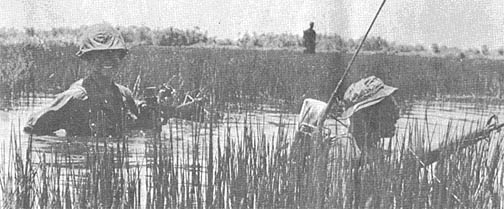 |
| IF I WERE TALLER - Specialist 4 Luther Williams (right) of Halifax, N.C., a radio-telephone operator with the 4th Bn (Mech), 23d Inf makes the initial “drop” into the swamps 12 kms northwest of Saigon. |
 |
THE GOOD WORD - ”Enough of these swamps, let’s go back,” says Captain Henry Montgomery (left) of Memphis, Tenn. The Tomahawks were in search of enemy weapons caches. |
| CHECK IT OUT CAREFULLY - Company A point man Private First Class Jerry Riggins of Durham, N.C., checks out a hazardous hedgerow. | 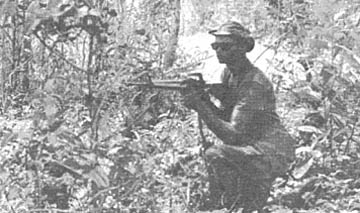 |
Page 8 TROPIC LIGHTNING NEWS July 15, 1968
Unit of The Week
Proud Past Spotlites 2/34
The history of the 2d Bn, 34th Armor Regt is the story of valiant
men performing valiant deeds, from the beaches of Normandy to the streets of
Berlin, to the rice paddies of Vietnam.
The 34th Armor was activated on October 1, 1941 at Fort Knox, Ky.
After extensive training in Kentucky, California and New York, the regiment
moved overseas to the Wiltshire area in England where it continued preparations
for ‘D’ Day and the landing on the French coast as part of General
Patton’s 3d Army.
Spearheading the 5th Armor Div throughout the drive across Europe
the 34th Armor added Normandy, Belgium, Luxembourg, Faleise, The Siegfried Line,
Hurtgin Forest and Roer River to its battle history. On September 11, 1944
the 2nd Bn, 34th Armor was the first unit to dispatch word to higher
headquarters that Americap soldiers were fighting on German soil.
In these campaigns, the 2d Bn, 34th Armor was awarded five campaign
streamers for actions in Normandy, Northern France, Rhineland, Ardennes-Allsace
and Central Europe. In addition, the battalion was awarded two
decorations; Distinguished Unit Citation, Embroidered Roer River Dam and
streamer, Croix De Guerre, Embroidered Luxembourg.
Recalled to battle on August 21, 1966, the 2d Bn, 34th Armor was
called upon and deployed for combat in the Republic of Vietnam. The
battalion reached Vietnam in September of 1966.
Once aground, the battalion was split, A Trp attached to the 25th
Inf Div at Cu Chi and B Trp attached to the 1st Inf Div at Phu Loi. The
battalion, with its remaining two troops moved to a permanent base camp at Long
Binh.
In October, 1966, the battalion moved out on its first operation.
Operation Shenandoah had begun and the battalion’s name first appeared in the
speech of the units it supported. Other operations came along, Attleboro,
Lancaster, Cedar Falls, Ala Monana and Junction City.
From Operation Junction City came one of the most famous battles of
the Vietnam war, the battle of Soui Tre, later called the battle of LZ Gold.
For its part, the 2d Bn, 34th Armor was recommended for the Presidential Unit
Citation.
Since then, through operations Yellowstone, Saratoga, Resolved to
Win and Certain Victory, and recently, Quyet Thang and Toan Thang have seen the
fighting spirit of the 2d Bn, 34th Armor.
Wolfhounds Return After 73 Hard Days
2D BDE - After 73 days on combat operations, the 1st
Bn, 27th Inf
Wolfhounds returned to Cu Chi for four days of rest and a change of command
ceremony.
During their extensive combat activities the “First of the
Wolfhounds” were credited with killing 230 enemy. They tallied some
40,000 pounds of rice captured and destroyed 377 enemy bunkers. Also during
their operations they captured 88 rifles, carbines and pistols, 84 rockets and
mortars and numerous enemy documents along with one 75mm recoilless rifle and
132 grenades.
Commanded by Lieutenant Colonel Ernest F. Condina, the Wolfhounds
operated in the Saigon-Hoc Mon area since last leaving Cu Chi on March 28.
Condina praised his men saying they performed “in an outstanding
professional manner” during the 2 1/2 months of long, hard fighting.
While at Cu Chi the Wolfhounds held a change of command ceremony
during which Lieutenant Colonel Stanford M. Touchstone received the colors of
the Wolfhound battalion from Condina.
The Tropic Lightning troopers again left Cu Chi June 13th to
continue combat operations in the Saigon-Hoc Mon area.
Persistent Enemy Grenade Vs Hard-Headed Medic
2D BDE - Being hard-headed can sometimes cause problems, but for
Specialist 4 Bruce Cotta, a medic with the 1st Bn (Mech), 5th Inf, it saved his
life.
The 25th Inf Div battalion’s night position 33 kms northwest of
Saigon was under heavy enemy mortar and RPG attack when the cry “medic!”
rang out. Low crawling, the 21-year-old medic inched his way toward the
wounded man.
“Suddenly something hit me on the head,” Cotta recalled, “and
I saw stars. I felt my head to see if it was still there.” It was, along
with a big “goose egg.
The flares dropping overhead to light the perimeter revealed a
Chinese-made hand grenade on the ground in front of him - the culprit that had
just struck him. The Tropic Lightning trooper picked up the grenade and
heaved it yelling a warning to those around him.
He continued on but hadn’t traveled far when he encountered the
villainous grenade again. This time it exploded wounding the Lowell,
Mass., medic.
Despite the shrapnel in his leg Cotta moved on to administer
medical aid to the wounded man.
“I still don’t know why it didn’t go off sooner,” Cotta
said after the incident. “I’m just glad that I have a hard head and
Charlie has second rate grenades.”
Thanks to
Don Casteel, 2nd Bn., 14th Inf. for sharing this issue,
Kirk Ramsey, 2nd Bn., 14th Inf. for creating this page.
This page last modified 8-12-2004
©2004 25th Infantry Division Association. All rights reserved.